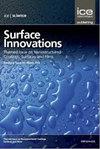Effect of graphene-family incorporation on corrosion performance of PEO coatings formed on titanium alloys: a mini review
IF 3.5
4区 材料科学
Q3 CHEMISTRY, PHYSICAL
引用次数: 3
Abstract
By being exposed to air or moisture or by a chemical reaction, titanium forms an oxide layers on its surface, which is stable and tightly adherent and provides it with protection from the environment, since titanium is a reactive material. Due to their extremely low thickness (∼10 nm), this oxide layer is easy to destroy under corrosion conditions. Through plasma electrolytic oxidation (PEO), titanium and titanium alloys can be equipped with thick and adhesive TiO2 coatings to enhance their surface characteristics. In the PEO process, TiO2 composite coatings can be formed by mixing proper additives with electrolytes, such as powders, particles, sheets, or compounds. The graphene and its family derivatives (i.e., graphene oxide and reduced graphene oxide) are among the most popular additives used in PEO composite coatings due to their high stability in corrosive media. Graphene family nanosheets can accumulate in PEO coatings because of their porous nature, changing the surface characteristics dramatically. The use of graphene family nanosheets in the electrolyte can be useful to reduce coating porosity and improve final corrosion properties by adjusting electrolyte conditions. Therefore, the diffusion pathways for corrosive ions in composite TiO2 coatings become considerably more tortuous than with pure TiO2.石墨烯家族掺入对钛合金PEO涂层腐蚀性能的影响:综述
由于钛是一种反应性材料,在暴露于空气或湿气或化学反应时,钛在其表面形成一层氧化层,这种氧化层稳定而紧密地附着在一起,并为其提供保护,使其免受环境的影响。由于其极低的厚度(~ 10nm),这种氧化层在腐蚀条件下很容易被破坏。通过等离子体电解氧化(PEO),钛和钛合金可以涂上厚而粘接的TiO2涂层,以增强其表面特性。在PEO工艺中,通过将适当的添加剂与电解质混合,如粉末、颗粒、片状或化合物,可以形成TiO2复合涂层。石墨烯及其家族衍生物(即氧化石墨烯和还原氧化石墨烯)是PEO复合涂料中最受欢迎的添加剂之一,因为它们在腐蚀性介质中具有很高的稳定性。石墨烯家族纳米片由于其多孔性,可以在PEO涂层中积累,从而显著改变其表面特性。在电解质中使用石墨烯家族纳米片可以通过调节电解质条件来减少涂层孔隙率和改善最终腐蚀性能。因此,腐蚀离子在复合TiO2涂层中的扩散路径比在纯TiO2涂层中要曲折得多。
本文章由计算机程序翻译,如有差异,请以英文原文为准。
求助全文
约1分钟内获得全文
求助全文
来源期刊

Surface Innovations
CHEMISTRY, PHYSICALMATERIALS SCIENCE, COAT-MATERIALS SCIENCE, COATINGS & FILMS
CiteScore
5.80
自引率
22.90%
发文量
66
期刊介绍:
The material innovations on surfaces, combined with understanding and manipulation of physics and chemistry of functional surfaces and coatings, have exploded in the past decade at an incredibly rapid pace.
Superhydrophobicity, superhydrophlicity, self-cleaning, self-healing, anti-fouling, anti-bacterial, etc., have become important fundamental topics of surface science research community driven by curiosity of physics, chemistry, and biology of interaction phenomenon at surfaces and their enormous potential in practical applications. Materials having controlled-functionality surfaces and coatings are important to the manufacturing of new products for environmental control, liquid manipulation, nanotechnological advances, biomedical engineering, pharmacy, biotechnology, and many others, and are part of the most promising technological innovations of the twenty-first century.
 求助内容:
求助内容: 应助结果提醒方式:
应助结果提醒方式:


